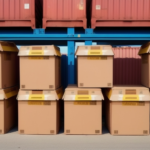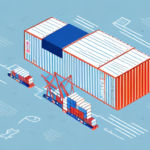Understanding Ocean Freight Rates for International Shipping of Household Goods
International shipping of household goods is a complex process that requires meticulous planning and consideration. One of the most critical aspects of this process is understanding the ocean freight rates associated with international shipping. This comprehensive guide will provide you with detailed insights into ocean freight rates, helping you navigate the intricacies of shipping your household goods overseas.
Ocean Freight Shipping 101: A Comprehensive Guide for Household Goods
Shipping household goods internationally by sea involves using cargo containers to transport your belongings via cargo vessels across international waters. Typically, shipping companies charge a flat rate per container, along with additional fees for services such as insurance, packing, and customs clearance.
When determining the cost of ocean freight shipping, several factors come into play:
- Shipping Route Distance: Longer routes may incur higher costs due to increased fuel consumption and transit time.
- Weight and Volume: The size and weight of your cargo significantly affect the overall cost.
- Container Type: Different containers (e.g., standard, refrigerated) come with varying costs.
- Transportation Mode: Options like door-to-door or port-to-port shipping impact pricing.
Choosing the right container type is essential. Options include:
- Standard Dry Containers: Suitable for most household goods.
- Refrigerated Containers: Necessary for perishable items requiring temperature control.
- Open-Top Containers: Ideal for oversized or heavy items.
Ocean freight shipping timelines can range from several weeks to months, depending on the destination and route. It's crucial to plan ahead to ensure your goods arrive when needed, especially for specific events or deadlines.
The Factors Affecting Ocean Freight Rates for International Shipping
Several elements influence ocean freight rates, including:
- Fuel Costs: Fluctuations in fuel prices directly impact shipping rates.
- Demand for Services: High demand can drive prices up, especially during peak seasons.
- Vessel Availability: Limited availability can result in higher costs.
- Additional Fees: Costs such as customs clearance, security, and documentation fees are often included.
The International Maritime Organization (IMO) reports that fuel costs constitute a significant portion of shipping expenses, accounting for approximately 50% of total operational costs.
Geopolitical events and natural disasters can also impact freight rates by causing route disruptions or increasing security measures. For example, political instability in key shipping regions may lead to higher insurance premiums and delayed shipments.
An Overview of the International Shipping Industry and Its Trends
The international shipping industry is dynamic, with emerging technologies and evolving trends shaping its future:
- E-commerce Growth: The rise of online shopping has significantly increased the demand for international shipping services.
- Technological Advancements: Innovations such as automated containers and blockchain for tracking shipments enhance efficiency.
- Sustainability Focus: Shipping companies are investing in eco-friendly technologies, including alternative fuels and energy-efficient vessels, to reduce their environmental footprint.
According to a McKinsey report, the shipping industry is expected to achieve a 20% reduction in carbon emissions by 2030 through the adoption of green technologies.
How to Compare and Choose the Best Ocean Freight Rates for Your Household Goods
With numerous shipping companies offering ocean freight services, selecting the best option requires careful comparison:
- Assess Your Shipping Needs: Determine your desired delivery date, cargo size, and weight.
- Request Multiple Quotes: Compare rates from different shipping companies to find the most competitive pricing.
- Evaluate Service Quality: Consider customer reviews, satisfaction ratings, and the company’s reputation.
- Check Container Options: Ensure the company offers the appropriate container type for your goods.
- Review Security Measures: Verify the company implements robust security protocols to protect your valuables.
It's important to balance cost with reliability. The cheapest option may not always provide the best service, so consider the overall value and dependability of each shipping company.
Understanding the Different Ocean Freight Containers and Their Pros and Cons
Various types of ocean freight containers cater to different shipping needs:
- Standard Dry Containers: Versatile and suitable for most household goods.
- Refrigerated Containers: Essential for perishable items requiring temperature control.
- Open-Top Containers: Facilitate the transportation of oversized or heavy items.
- Flat-Rack Containers: Ideal for bulky or unusually shaped cargo.
- Tank Containers: Designed for transporting liquids and gases, commonly used for chemicals and fuels.
- Ventilated Containers: Allow air circulation for goods that require it.
- Insulated Containers: Maintain consistent temperatures for sensitive cargo.
Selecting the appropriate container type ensures the safe and efficient transport of your household goods.
Tips for Packing Your Household Goods for Safe Shipping Overseas
Proper packing is crucial for the safe transportation of your household goods. Follow these tips to minimize the risk of damage:
- Use High-Quality Materials: Sturdy boxes, packing tape, bubble wrap, and packing peanuts provide necessary protection.
- Label Clearly: Mark boxes with their contents and handle with care symbols to guide handlers.
- Optimize Packing: Avoid overpacking to reduce the risk of items shifting and causing damage.
- Disassemble Large Items: Break down furniture and appliances to prevent breakage and facilitate easier transport.
- Secure Hazardous Materials: Pack and label hazardous items according to international shipping regulations.
For detailed packing guidelines, consult with a professional moving company or refer to resources provided by reputable organizations such as the New Zealand Immigration.
Documents You Need to Prepare When Shipping Your Household Goods Internationally by Ocean Freight
Proper documentation is essential for smooth international shipping. Ensure you have the following documents ready:
- Itemized Inventory: A detailed list of all items being shipped.
- Bill of Lading: Confirms ownership and outlines the terms of shipment.
- Customs Declaration Form: Required for customs clearance and compliance with international regulations.
- Import Permits: Necessary for certain goods depending on the destination country’s regulations.
- Certificates of Origin: Verify the origin of the shipped goods, which may be required for customs processing.
Always verify specific documentation requirements with your shipping company and the destination country's customs authority.
An In-Depth Look at Different Ocean Freight Routes and Their Costs
Ocean freight rates vary significantly based on the chosen shipping route. Factors influencing costs include distance, demand, and route popularity:
- North America to Europe: Typically more expensive due to high demand and shorter transit times.
- Asia to Europe: Relatively affordable but subject to fluctuations based on fuel prices and geopolitical tensions.
- Multiple Ports of Call: Can be more cost-effective but may result in longer transit times.
According to the Global Container Shipping Market Report, shipping rates from Asia to Europe averaged $1,800 per TEU (twenty-foot equivalent unit) in 2023.
How to Track Your Shipment of Household Goods from Origin to Destination
Tracking your shipment is essential for peace of mind and efficient planning. Most shipping companies offer the following tracking features:
- Online Tracking Portals: Real-time updates on your cargo's location and estimated arrival time.
- Notifications: Regular updates via email or SMS about your shipment’s status.
- Customer Support: Access to customer service representatives for inquiries and assistance.
Ensure your shipping provider offers comprehensive tracking services to keep you informed throughout the shipping process.
Customs Clearance Procedures and Regulations When Shipping Household Goods Internationally by Ocean Freight
Customs clearance is a critical step in international shipping. To facilitate a smooth process:
- Accurate Documentation: Ensure all paperwork is complete and accurate to avoid delays.
- Compliance with Regulations: Adhere to the import and export laws of both the origin and destination countries.
- Payment of Duties and Taxes: Be prepared to pay any applicable customs duties and taxes.
- Licenses and Permits: Obtain necessary licenses for restricted or regulated items.
Consult with a customs broker or your shipping company to ensure all requirements are met.
Common Mistakes to Avoid When Shipping Your Household Goods Internationally by Ocean Freight
To ensure a hassle-free shipping experience, avoid the following common mistakes:
- Choosing Based Solely on Price: The cheapest option may compromise on reliability and service quality.
- Poor Packing: Inadequate packing can lead to damaged or lost items.
- Neglecting Insurance: Failing to secure adequate insurance can result in significant losses if goods are damaged or lost.
- Incomplete Documentation: Missing or incorrect paperwork can cause delays and additional fees.
By being aware of these pitfalls, you can take proactive steps to ensure the safety and timely delivery of your household goods.
The Benefits of Using a Professional Moving Company for Your International Household Goods Shipping Needs
Engaging a professional moving company offers numerous advantages when shipping household goods internationally:
- Expertise: Professionals have extensive knowledge of shipping regulations, packing techniques, and logistics management.
- Comprehensive Services: From packing and loading to customs clearance and delivery, comprehensive support is provided.
- Insurance Options: Access to various insurance plans to protect your belongings during transit.
- Time and Stress Savings: Professionals handle the complexities, allowing you to focus on other aspects of your move.
According to the American Moving and Storage Association, professional movers reduce the risk of damage to household goods by up to 70% compared to DIY moves.
In summary, understanding ocean freight rates for international shipping of household goods is essential for a smooth and stress-free experience. By researching and comparing shipping companies, selecting the appropriate container type, and adhering to proper packing and documentation procedures, you can ensure that your household goods arrive safely and on schedule.






















